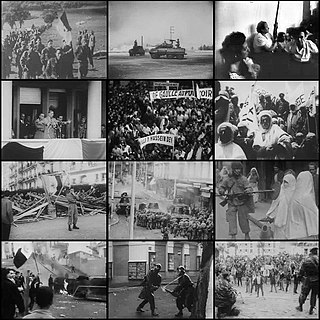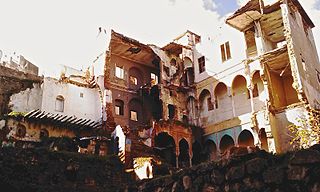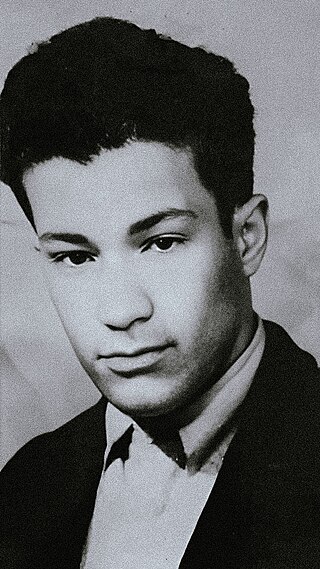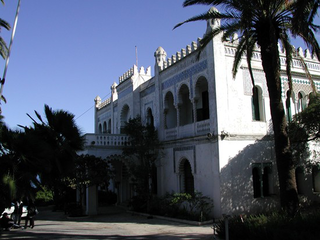
The Algerian War was a major armed conflict between France and the Algerian National Liberation Front (FLN) from 1954 to 1962, which led to Algeria winning its independence from France. An important decolonization war, it was a complex conflict characterized by guerrilla warfare and war crimes. The conflict also became a civil war between the different communities and within the communities. The war took place mainly on the territory of Algeria, with repercussions in metropolitan France.

The Paris massacre of 1961 was the mass killing of Algerians who were living in Paris by the French National Police. It occurred on 17 October 1961, during the Algerian War (1954–62). Under orders from the head of the Parisian police, Maurice Papon, the National Police attacked a demonstration by 30,000 pro-National Liberation Front (FLN) Algerians. After 37 years of denial and censorship of the press, in 1998 the government finally acknowledged 40 deaths, while some historians estimate that between 200 and 300 Algerians died. Death was due to heavy-handed beating by the police, as well as mass drownings, as police officers threw demonstrators into the river Seine.

Larbi Ben M'hidi, commonly known as Si Larbi or simply as Ben M'hidi, was a prominent Algerian revolutionary leader during the Algerian war of independence. He is one of the six founding members of the Front de Libération Nationale that launched an armed revolt throughout Algeria and issued a proclamation calling for a sovereign Algerian state.

Saadi Yacef was an Algerian independence fighter, serving as a leader of the National Liberation Front during his country's war of independence. He was a Senator in Algeria's Council of the Nation until his death.
Latifa Ben Mansour is an Algerian writer, psychoanalyst, and linguist. Her work deals with issues such as the role of women in Algerian society, Islamic extremism, storytelling, trauma, and memory.

The Battle of Algiers was a campaign fought during the Algerian War. It consisted of urban guerrilla warfare and terrorist attacks carried out by the National Liberation Front (FLN) against the French authorities in Algiers, and by the French authorities, army, and French terrorist organizations against the FLN. Both sides targeted civilians throughout the battle. The conflict began with attacks by the FLN against the French forces and Pieds-Noirs followed by a terrorist attack on Algerian civilians in Algiers by a group of settlers, part of the terrorist group "La Main Rouge", aided by the police. Reprisals followed and the violence escalated, leading the French Governor-General to deploy the French Army in Algiers to suppress the FLN. Civilian authorities gave full powers to General Jacques Massu who, operating outside legal frameworks between January and September 1957, eliminated the FLN from Algiers. The use of torture, forced disappearances and illegal executions by the French later caused controversy in France.
Erwan Bergot was a French Army officer and author; he served in the French Army during the First Indochina War and Algerian War.

Arris is a commune in the Batna wilaya in eastern Algeria.
The Battle of Philippeville, also known as the Philippeville massacre or the August Offensive was a series of raids launched on 20 August 1955 on various cities and towns of the Constantine region by FLN insurgents and armed mobs during the Algerian War between France and Algerian rebels. The raids, which mostly took the form of ethnic riots, resulted in the massacre of several dozens of European settlers known as Pieds-Noirs. These massacres were then followed by reprisals by the French army and Pieds-Noirs vigilantes, which resulted in the death of several thousand Muslim Algerians. The events of late August 1955 in the Constantinois region are considered to be a major turning point of the Algerian War.

The Battle of Bab el Oued was a violent confrontation which occurred during the latter stages of the Algerian War (1954–1962) between the French Army and the Organisation armée secrète (OAS) which opposed Algerian independence. It took place in Bab El Oued, then a working-class European quarter of Algiers, from 23 March to 6 April 1962.
The First Battle of El Djorf took place on 22 September 1955, during the Algerian War, between the National Liberation Army and the French Army.

Mourad Didouche was an Algerian revolutionary, and a political and military figure of the Algerian War of Independence.
Youcef Zighoud, also known as Colonel Si Ahmed, was an Algerian FLN party fighter during the Algerian War. On August 20, 1955, he planned an attack against the French occupation in Philippeville and its surroundings commonly referred to as the Battle of Philippeville. The attack led to a harsh crackdown and repression by the French government. While numbers are disputed, the conflict resulted in between 1,239 and 12,000 deaths. Zighoud, from whom the town of Zighoud Youcef takes its name, was killed in Sidi Mezghiche during a clash with the French Army.

The Ambush of Palestro, or Ambush of Djerrah, took place on the 18th May 1956, during the Algerian war, near the village of Djerrah in the region of Palestro in Kabylie. A section of about forty men from the National Liberation Army (ALN) under the command of Lieutenant Ali Khodja ambushed a unit of 21 men from the 9th Colonial Infantry Regiment of the French Army commanded by Second Lieutenant Hervé Artur.
Operation Véronique was an unsuccessful military operation undertaken by the French Army during the Algerian War in the hope of eradicating the FLN.

The villa Sésini is a torture center established in El Biar during the Algerian war in the city of Algiers.
Mohamed Aïchaoui was an Algerian journalist and militant in the nationalist movement against French Algeria. Aïchaoui wrote the Declaration of 1 November 1954, the National Liberation Front's first appeal to the Algerian people at the start of the Algerian War. After earlier imprisonment and torture, he died in a 1959 clash with the French army.
The Declaration of 1 November 1954 is the first independentist appeal addressed by the National Liberation Front (FLN) to the Algerian people, marking the start of the Algerian Revolution and the armed action of the National Liberation Army (ALN).
Ahmed Mahsas was an Algerian militant in the nationalist movement against French Algeria.

Benaouda Benzerdjeb was an Algerian doctor, born on February 9, 1921, in Tlemcen and died on January 16, 1956, in the village of Ouled Halima, near Sebdou, 36 km from Tlemcen. He was the first medical martyr to die during the Algerian war.










